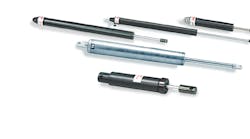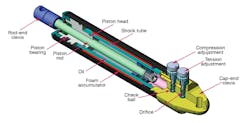Pneumatics has many strengths: high-speed and rapid-cycling capabilities, high reliability and repeatability, and clean, safe operation because electricity is not needed. However, motion control can be a challenge because the compressibility of air can produce spongy operation. Sometimes spongy operation is desirable by serving as a cushion to compensated for shock loading. Flow-control valves can be used to limit speed, but the compressibility of air can make speed difficult with changing loads. Having to stop and hold a load in place mid-stroke usually requires some sort of mechanical mechanism.
In most cases, applications requiring precise mid-stroke positioning and motion control using pneumatics require sophisticated electronic closed-loop control. However, ITT Enidine offers its ADA series rate controls as a cost-effective alternative to electronics. ITT’s rate controls regulate the speed or time required for a mechanism to move from one position to another. They are typically used to control pneumatic cylinders, linear slides, lids, and other moving mechanisms.
Depending on the model specified Series ADA rate controls regulate the speed of extension, retraction, or both in pneumatic and other mechanism. Shown here is a sectional view highlighting the internal features of a double-acting, adjustable rate control.
How They Work
Series ADA rate controls route oil through an orifice to dampen motion and limit speed. Because the oil is highly incompressible, speed is controlled by the size of the orifice and is much less affected by changes in load. The rate controls are available in single-acting versions to control speed during extension (tension), retraction (compression), or both. Referring to the illustration, resistance to motion is controlled by adjusting a mechanism that either increases or decreases the size of an orifice.
When a compressive load acts to retract the rate control’s piston rod, oil is forced through a compression orifice and flows freely through a check valve to bypass the tension orifice and to the rod end of the shock tube. A foam accumulator collects the volume of oil displaced by the piston rod. When a tensile load extends the rod, oil flows through an internal flow path in the shock tube and is forced through the tension orifice adjustment cartridge. The flow unseats a check valve in the compression cartridge and free flows into the cap end of the shock tube.
Speed for extension and retraction can be adjusted independently, and the rate controls are also available in non-adjustable versions (DA series) to provide tamper-proof operation once the desired rate has been determined. An optional remote adjustment cable allows adjustment in otherwise inaccessible locations for the ADA 500 Series.
The advantages of using rate controls include:
Extended machine life—The use of rate controls significantly reduces shock and vibration to machinery caused by uncontrolled machine operation. This further reduces machinery damage, downtime, and maintenance costs, while increasing machine life.
Improved production quality—Harmful effects of uncontrolled motion, such as noise, vibration, and damaging impacts, are moderated or eliminated so that production quality is improved.
Safer machine operation—Rate controls protect machinery and equipment operators by offering predictable, reliable, and controlled machine operation.
For more information, call ITT Enidine at (800) 852-8508, or click here.



